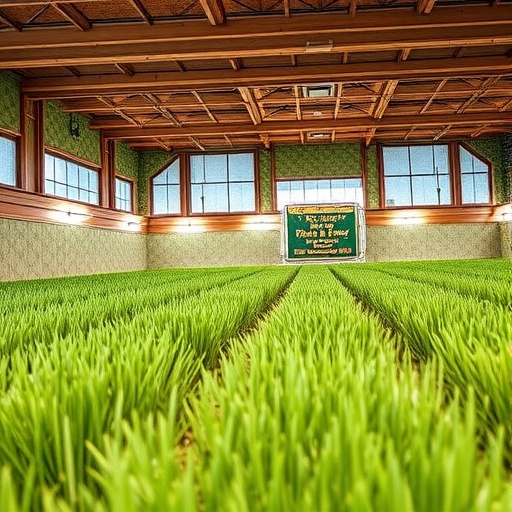In the evolving landscape of sustainable architecture and eco-friendly building practices, innovative solutions are sought that address both environmental concerns and material efficiency. A recent study led by researchers including Cosentino, Ferreira, and Fernandes explores an unexpected yet promising resource in this quest: the invasive plant species Cortaderia selloana, commonly known as pampas grass. This plant, often viewed as a nuisance due to its rapid spread and negative impact on local ecosystems, is now emerging as a viable candidate for sustainable building insulation.
The team’s findings suggest that Cortaderia selloana could be transformed into biomass insulation, providing an environmentally sound alternative to synthetic insulation materials that dominate the construction industry. Historically, the production of building insulation has involved significant reliance on petrochemical resources, which have been linked to pollution and greenhouse gas emissions. The shift towards utilizing renewable biological resources, like invasive plant species, has the potential to disrupt this trend while simultaneously addressing ecological issues.
The process by which Cortaderia selloana is converted into insulation involves several technical steps centered around biomass valorization. Initially, the collected plant material undergoes drying and shredding to prepare it for further processing. This transforms the ample, fibrous structure of pampas grass into a more manageable state for processes such as carbonization or thermal treatment. Each method explores how temperature variations affect the final properties of the material, leading to a range of insulation performance characteristics.
Significant attention is drawn to the thermal properties of the produced insulation. The study reveals that with appropriate processing conditions, the resulting insulation material demonstrates superior thermal efficiency, highlighting its potential role in energy-efficient building designs. Enhanced thermal resistance can lead to reduced heating and cooling demands in residential and commercial spaces, thus lowering energy consumption and greenhouse gas emissions over the building’s lifespan.
Moreover, the environmental impact of utilizing Cortaderia selloana extends beyond just energy savings. The process contributes to biodiversity conservation by managing the overpopulation of this invasive species, which, when left unchecked, can outcompete native flora and disrupt local ecosystems. By harvesting this plant for insulation, the study posits that communities can turn a problematic plant into a resource, fostering a more sustainable relationship with the environment.
In addition to thermal performance and ecological benefits, the economic implications of this research present a compelling case for wider adoption of biomass insulation. The cultivation and processing of invasive species like Cortaderia selloana may create new economic opportunities in terms of job creation in local communities focused on sustainable practices. This shift can stimulate markets for alternative materials, promoting an economy that values renewable resources.
However, challenges remain in raising awareness and overcoming preconceived notions regarding the use of invasive plants. Educational outreach efforts are crucial in promoting the benefits of sustainably sourced materials. Engaging developers, architects, and builders will be essential to encourage the incorporation of biomass insulation into new building projects, reinforcing the principles of sustainability.
As the construction industry increasingly gravitates towards innovative materials, the use of biomass derived from invasive species presents a dual solution—combating environmental challenges posed by these plants while addressing the pressing need for sustainable building practices. This research aligns with a global movement advocating for materials that are both innovative and earth-friendly, further substantiating the importance of multidisciplinary approaches to ecological problems.
The implications of this study extend beyond just building insulation. Researchers continue to explore how similar methodologies can be applied to other invasive species, presenting opportunities to develop a broader range of sustainable materials. The conversion of biomass from invasive plants into usable materials illustrates a positive feedback loop; reducing environmental degradation and promoting sustainable practices simultaneously.
While the promise of using Cortaderia selloana as a sustainable insulation material is substantial, this exploratory study is just the beginning. Future research will undoubtedly delve deeper into optimizing processing techniques, understanding the long-term performance of biomass insulation, and exploring the dynamic properties of various invasive plant species. This knowledge will enhance the science underpinning the use of renewable materials in construction.
As society increasingly recognizes the urgency of sustainable practices, the potential of turning invasive species into valuable resources stands as a beacon of innovative thinking. These advancements challenge conventional approaches to building materials, promising brighter, more sustainable futures for the construction industry and our planet. By redefining our relationship with nature and its resources, we take meaningful steps towards a more environmentally responsible future.
Ultimately, the research led by Cosentino, Ferreira, and Fernandes not only contributes uniquely to the realm of materials science but also puts forth an inspiring vision of how complex global challenges can be addressed through ingenuity and sustainability. The ripple effects of their findings are poised to influence policy decisions and encourage a paradigm shift in how we consider invasive species—not as mere weeds but as untapped resources with the potential for transformative environmental benefits.
Harnessing this potential, enhancing our building materials, and promoting ecological stewardship agglomerate to encapsulate a hopeful narrative for sustainability in the face of climate change. The journey of Cortaderia selloana from invader to an ecological ally in our homes and buildings may serve as a template for future innovations that rely on nature’s bounty rather than depleting its resources.
Subject of Research: The use of invasive Cortaderia selloana as sustainable building insulation.
Article Title: Turning Invasive Cortaderia Selloana into Sustainable Building Insulation: A Biomass Valorization Approach.
Article References:
Cosentino, L., Ferreira, D., Fernandes, J. et al. Turning Invasive Cortaderia Selloana into Sustainable Building Insulation: A Biomass Valorization Approach. Waste Biomass Valor (2025). https://doi.org/10.1007/s12649-025-03403-z
Image Credits: AI Generated
DOI: https://doi.org/10.1007/s12649-025-03403-z
Keywords: Biomass valorization, sustainable building materials, Cortaderia selloana, insulation, invasive species management.




